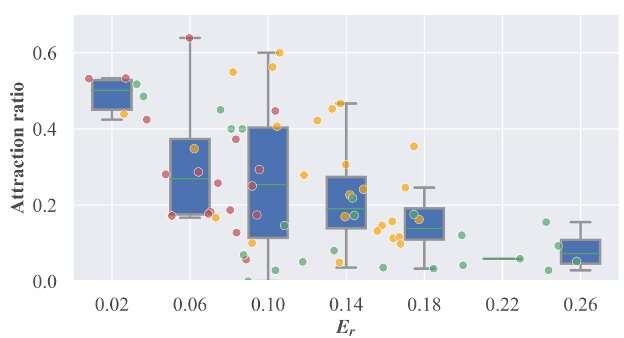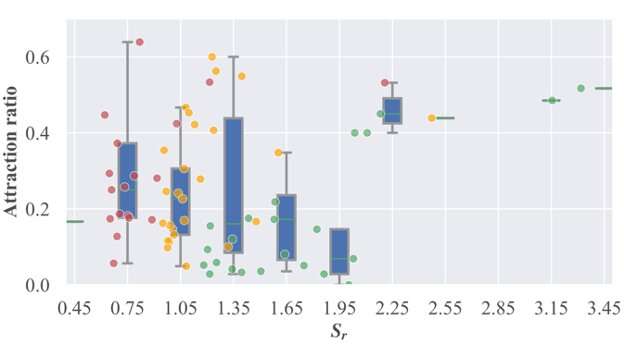
In recent decades, engineers have created a wide range of robotic systems inspired by animals, including four legged robots, as well as systems inspired by snakes, insects, squid and fish. Studies exploring the interactions between these robots and their biological counterparts, however, as still relatively rare.
Researchers at Peking University and China Agricultural University recently set out to explore what happens when live fish are placed in the same environment as a robotic fish. Their findings, published in Bioinspiration & Biomimetics, could both inform the development of fish-inspired robots and shed some new light on the behavior of real fish.
“Our research team has been focusing on the development of self-propelled robotic fish for a considerable amount of time,” Dr. Junzhi Yu, one of the researchers who carried out the study, told Tech Xplore. “During our field experiments, we observed an exciting phenomenon where live fish were observed following the swimming robotic fish. We are eager to further explore the underlying principles behind this phenomenon and gain a deeper understanding of this ‘fish following’ behavior.”
The key objective of the recent work by Dr. Yu and his colleagues was to gather new insight about how fish interact with the fish-like robots developed by their lab, as this could benefit both the robotics and biology research communities. The robotic fish used in their experiments was carefully designed to replicate the appearance, body shape, and movements of koi fish, large and colorful freshwater fish originating from Eastern Asia.

“Using the central pattern generator (CPG) model, we have developed a control system that generates rhythm signals for the oscillations of our system’s two concatenated joints,” Dr. Yu explained. “These signals drive the flexible caudal fin to swing, and produce anti-Karman vortex street, which enables our robotic fish to achieve a body-caudal fin (BCF) motion similar to that of koi fish. This design allows our robotic fish to self-propelled swim efficiently, making it an ideal tool for studying fish behavior.”
In their experiments, Dr. Yu and his colleagues placed one or two prototypes of their koi fish-like robot in the same tank with one or more live fishes. They then observed how the fish behaved in the presence of this robot and assessed whether their behavior varied based on how many other live fish were present in the tank with them.
“The most notable achievement of our study is the analysis of experiments on quantity variation and parameter variation,” Dr. Yu said. “Through extensive experimentation, we discovered that live fish exhibit significantly lower proactivity when alone, and the most proactive case is one where a robotic fish is interacting with two real fish. In addition, our experiments on parameter variation indicated that live fish may respond more proactively to robotic fish that swim with high frequency and low amplitude, but they may also move together with the robotic fish at high frequency and high amplitude.”
The researchers’ observations shed an interesting new light on the collective behavior of fish, which could potentially guide the design of additional fish-like robots. Their work could also inspire other teams to explore the interactions between live animals and their robotic counterparts. This could in turn help to better understand the social behavior of these animals and how they would respond to robots if they were eventually introduced in their environment.
“One promising direction for the further development of robotic fish is the use of flexible materials such as dielectric elastomer to create silent and vibration-free propulsion technology,” Dr. Yu added. “This will enable us to achieve a higher level of bionic interaction between robotic fish and real fish, opening new possibilities for studying aquatic environments and marine life. With continued research and development in this area, we hope to develop some commercial products for interactive demonstrations.”
More information:
Ziye Zhou et al, Proactivity of fish and leadership of self-propelled robotic fish during interaction, Bioinspiration & Biomimetics (2023). DOI: 10.1088/1748-3190/acce87
© 2023 Science X Network
Citation:
Study observes the interactions between live fish and fish-like robots (2023, May 12)
retrieved 12 May 2023
from https://techxplore.com/news/2023-05-interactions-fish-fish-like-robots.html
This document is subject to copyright. Apart from any fair dealing for the purpose of private study or research, no
part may be reproduced without the written permission. The content is provided for information purposes only.
Stay connected with us on social media platform for instant update click here to join our Twitter, & Facebook
We are now on Telegram. Click here to join our channel (@TechiUpdate) and stay updated with the latest Technology headlines.
For all the latest Technology News Click Here
For the latest news and updates, follow us on Google News.
